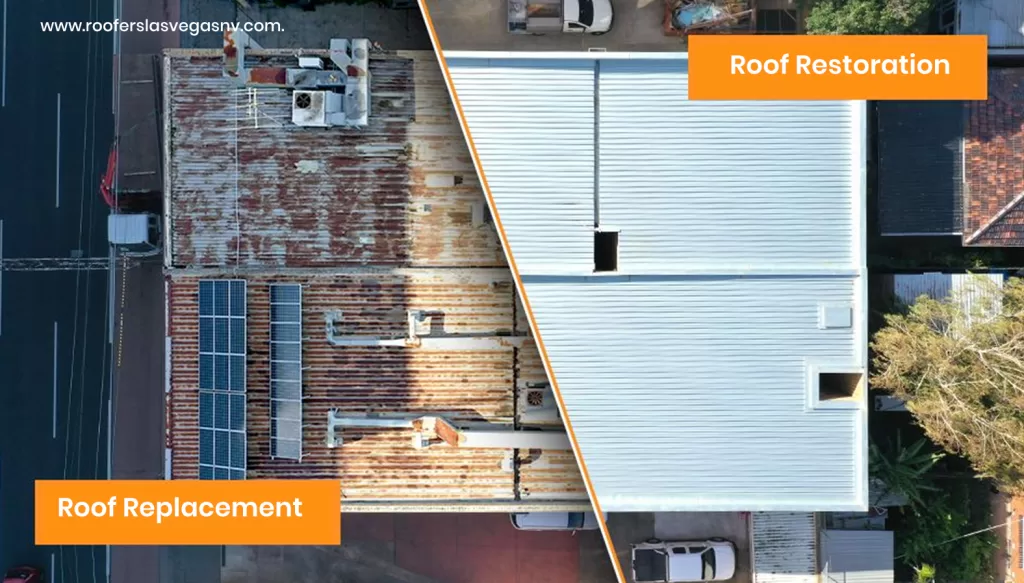Roof Restoration vs Replacement

Knowing the differences between roof restoration vs replacement is essential for making an informed decision that aligns with your needs and budget. Proper roof maintenance protects your home and extends its life. When your roof shows wear and tear, you may wonder whether to restore or replace it. Understanding these options empowers you to choose wisely.
Understanding Roof Restoration
Definition of Roof Restoration
Roof restoration involves cleaning, repairing, and recoating your existing roof. It’s designed to extend the life of your roof without the need for a complete overhaul.
Benefits of Roof Restoration
Restoring your roof can be cost-effective, less disruptive, and environmentally friendly. It improves the roof’s appearance and performance, often adding years to its life.
Cost of Roof Restoration
The cost of roof restoration is generally lower than replacement. It varies based on roof size, materials, and the extent of repairs needed but is typically a fraction of the cost of a new roof.
Ideal Situations for Roof Restoration
Roof restoration is ideal when the roof is structurally sound but has minor issues like leaks, damaged tiles, or faded coatings. It’s a suitable option for relatively young roofs that haven’t sustained significant damage.
Understanding Roof Replacement
Definition of Roof Replacement
Roof replacement involves removing the existing roof and installing a new one. This process ensures that all underlying issues are addressed and provides a fresh start with new materials.
Benefits of Roof Replacement
Replacing your roof offers the advantage of brand-new materials, which can significantly enhance the roof’s durability and performance. It’s a long-term solution that can last for decades with proper maintenance.
Cost of Roof Replacement
Roof replacement is more expensive than restoration due to the labor, materials, and disposal involved. However, it provides a new roof that can last 20-50 years, depending on the materials used.
Ideal Situations for Roof Replacement
Roof replacement is necessary when the roof is severely damaged, old, or has widespread issues that restoration can’t fix. It’s also a good choice for homeowners looking for a long-term solution.
Comparing Roof Restoration vs Replacement
Cost Comparison
If we talk about the roof restoration vs replacement, Restoration is generally cheaper than replacement, making it a more budget-friendly option for minor repairs and improvements. Replacement, though costlier upfront, can be more economical in the long run if the roof is nearing the end of its lifespan.
Longevity and Durability
A restored roof can last an additional 10-15 years, while a new roof can last 20-50 years. The longevity depends on the materials and maintenance of the roof.
Environmental Impact
Restoration is more environmentally friendly as it involves fewer materials and less waste. Replacement generates more waste but offers the chance to install eco-friendly roofing materials.
Time and Disruption
Restoration is quicker and less disruptive than replacement, which can take several days to weeks depending on the roof’s size and complexity.
Factors to Consider When Choosing
Age of the Roof
Older roofs nearing the end of their lifespan are better candidates for replacement, while newer roofs with minor issues may benefit from restoration.
Extent of Damage
Extensive damage, structural issues, or widespread leaks often necessitate replacement. Minor damage can be effectively addressed with restoration.
Budget Constraints
Budget plays a crucial role. Restoration is less expensive upfront, making it a viable option for those with limited funds. Replacement, while pricier, offers a longer-lasting solution.
Long-term Plans
Consider your long-term plans for the property. If you plan to stay for many years, a replacement might be more beneficial. If you plan to sell, restoration can improve the roof’s appearance and value.
Case Studies
Example of Successful Roof Restoration
A homeowner with a 10-year-old roof experienced minor leaks and fading. They opted for restoration, which involved cleaning, repairing, and recoating. The process was completed in a few days, costing significantly less than replacement. The restored roof added 15 years to its life.
Example of Successful Roof Replacement
Another homeowner had a 25-year-old roof with extensive damage and leaks. They chose to replace the roof entirely. The new roof, made with high-quality materials, provided a fresh start and significantly improved the home’s energy efficiency.
Expert Opinions
Insights from Roofing Contractors
Roofing contractors often recommend restoration for younger roofs with minor issues and replacement for older, extensively damaged roofs. They emphasize the importance of regular maintenance to extend the roof’s life.
Homeowner Testimonials
Homeowners who opted for restoration appreciated the cost savings and minimal disruption. Those who chose replacement valued the peace of mind and long-term benefits of a new roof.
Conclusion
Deciding between roof restoration and replacement depends on various factors, including the age and condition of your roof, budget, and long-term plans. Both options have their benefits and drawbacks, so it’s essential to evaluate your specific situation. Consulting with roofing professionals can provide valuable insights and help you make the best decision for your home.
FAQs
What is the difference between roof restoration and replacement?
Roof restoration involves repairing and recoating an existing roof to extend its life, while replacement involves removing the old roof and installing a new one.
How long does roof restoration last compared to replacement?
A restored roof can last an additional 10-15 years, whereas a new roof can last 20-50 years, depending on the materials used.
Can all types of roofs be restored?
Most types of roofs can be restored, but the extent of the damage and the roof’s age are significant factors to consider.
Is roof restoration worth it?
Roof restoration is worth it for relatively new roofs with minor issues, offering a cost-effective and less disruptive solution.
What are the signs that a roof needs replacement?
Signs include widespread leaks, extensive damage, missing shingles, and the roof reaching the end of its expected lifespan.
